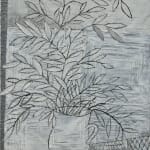ROBERT KOBAYASHI
White on White, 2012
Ceiling tin, paint, nails on wood
36 x 24 1/2 x 1 in.
Copyright The Estate of Robert Kobayashi
$ 45,000.00
Further images
In 2012, Dad was eighty-seven. That year was a furious burst of creativity, but he produced an especially haunting series of paintings, all in white. The only indication of shapes...
In 2012, Dad was eighty-seven. That year was a furious burst of creativity, but he produced an especially haunting series of paintings, all in white. The only indication of shapes and images is the contrast of the nails into the tin; I remember thinking it seemed unlike him, whose work was usually steeped in color and gradient and very defined surfaces. These were like looking through snow or fog. The timing of these works is very important: it was the last truly healthy year of his life, and as though he knew he was in a race against time. It would be hard to debate the significance of the absence of detail and color. He worked tirelessly on them, and my mom remembers him having a drive about them that was very different from his previous work. I saw them for the first time and felt a primal sadness.
I liken this last series of Dad’s work akin to a supernova: a brief and blinding flare of a beginning and an end. The works’ beauty is a painful reminder of the proximity that his death was to these paintings. When dad’s prognosis came from a doctor whose blank and impersonal tone felt like acid poured on a wound, my father stood up to shake his hand and said, “So that’s all?” My father’s dread of dying—stemming from early childhood and following him all the way until his death— squeezed itself into a brief and undramatic question. The quiet, staid dignity in White on White reminded me of the moment I witnessed my father gather up all of his fortitude to face the inevitable and acknowledge the messenger.
Shortly after the doctor’s appointment, where everything we feared was confirmed, we left as a family for Hawaii without a return date. My father knew that he wanted to go home to die, however much time it would take. The end of his life came full circle—his art that incorporated the overwhelming visual beauty that is Hawaii, and his ashes to be returned in part to the beaches, mountains, and skyscapes that birthed him. He died with a view of the Koolau mountain ridge and the rustle of trade winds running through the palm trees. After he was gone and my mom and I went back to Oahu, I saw the fog wreath the mountains early in the day before it got burnt off by the sun, and it would look remarkably like the works from 2012, everything bathed in a vaporous hue of white.
- Misa Kobayashi
I liken this last series of Dad’s work akin to a supernova: a brief and blinding flare of a beginning and an end. The works’ beauty is a painful reminder of the proximity that his death was to these paintings. When dad’s prognosis came from a doctor whose blank and impersonal tone felt like acid poured on a wound, my father stood up to shake his hand and said, “So that’s all?” My father’s dread of dying—stemming from early childhood and following him all the way until his death— squeezed itself into a brief and undramatic question. The quiet, staid dignity in White on White reminded me of the moment I witnessed my father gather up all of his fortitude to face the inevitable and acknowledge the messenger.
Shortly after the doctor’s appointment, where everything we feared was confirmed, we left as a family for Hawaii without a return date. My father knew that he wanted to go home to die, however much time it would take. The end of his life came full circle—his art that incorporated the overwhelming visual beauty that is Hawaii, and his ashes to be returned in part to the beaches, mountains, and skyscapes that birthed him. He died with a view of the Koolau mountain ridge and the rustle of trade winds running through the palm trees. After he was gone and my mom and I went back to Oahu, I saw the fog wreath the mountains early in the day before it got burnt off by the sun, and it would look remarkably like the works from 2012, everything bathed in a vaporous hue of white.
- Misa Kobayashi
1
of
41







